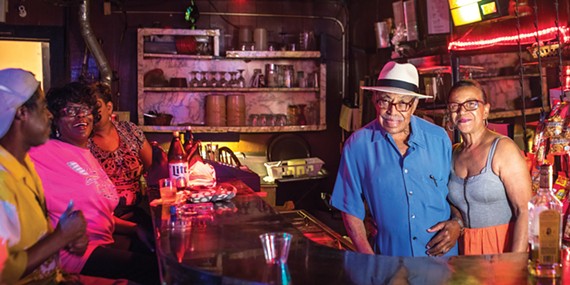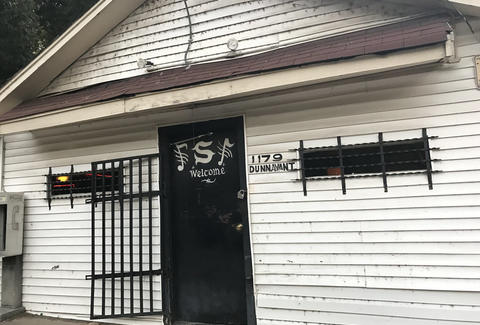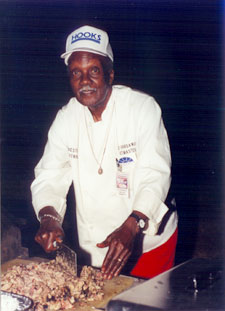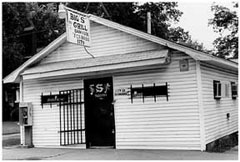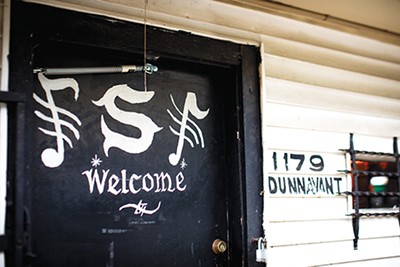
Virginia Roberts says she was loaned out by Jeffrey Epstein to his friend Prince Andrew, shown here. He denies they had sex.
All aboard the 'Lolita Express': Flight logs reveal trips Bill Clinton and Alan Dershowitz took on pedophile Jeffrey Epstein's private jet with anonymous women
Palm Beach multimillionaire Jeffrey Epstein is a free man, despite sexually abusing dozens of underage girls according to police and prosecutors. His victims have never had a voice, until now.
Virginia Roberts was working at Mar-a-Lago when she was recruited to be a masseuse to Palm Beach hedge fund manager Jeffrey Epstein. She was lured into a life of depravity and sexual abuse.
The girls who were abused by Jeffrey Epstein and the cops who championed their cause remain angry over what they regard as a gross injustice, while Epstein's employees and those who engineered his non-prosecution agreement have prospered.
For years, Jeffrey Epstein abused teen girls, police say. A timeline of his case
2005
March: A 14-year-old girl and her parents report that Jeffrey Epstein molested her at a mansion in Palm Beach. She said a female acquaintance and classmate at Royal Palm Beach High School had taken her to the house to give him a massage in exchange for money.
.jpg)
Jeffrey Epstein repeatedly engaged in sexual activity with underage girls at his waterfront Palm Beach home on El Brillo Way, according to police in the Town of Palm Beach. Epstein also owns residences in New York City and the U.S. Virgin Islands, among other locales.Emily Michot emichot@miamiherald.com
April: Palm Beach police begin trash pulls at Epstein’s home, discovering a telephone message for Epstein with the girl’s name on it, and a time that matched the time that she told police she was there. They find the names and phone numbers of other girls on message slips in his trash.October: With the police probe in full swing, one of Epstein’s assistants calls one of the girls just as she is being questioned by police. Investigators begin interviewing more girls, as well as Epstein’s butlers, who tell them that Epstein had frequent visits from girls throughout the day. On Oct. 20, they execute a search warrant at his house on El Brillo Way in Palm Beach.
2006
May: Police sign a probable cause affidavit charging Epstein and two of his assistants with multiple counts of unlawful sex acts with a minor. The Palm Beach state attorney, Barry Krischer, instead refers the case to a grand jury.

Town of Palm Beach police were unhappy with the handling of the Epstein case by then-State Attorney Barry Krischer.
June: The grand jury, after hearing from only one girl, returns an indictment of one count of solicitation of prostitution. The charge does not reflect that the victim in question and others were minors.
July: Epstein’s powerhouse legal team tries to negotiate a deal with the State Attorney’s Office. Lawyers discuss a deferred prosecution in which Epstein would enter a pretrial intervention program and serve no jail time.July: After pressure from the Palm Beach police chief, the FBI opens a federal investigation, dubbed “Operation Leap Year.’’ Documents list the possible crime as “child prostitution.’’November: The FBI begins interviewing potential witnesses and victims from Florida, New York and New Mexico.
2007
May: As the U.S. Attorney’s Office prepares to present the case to a federal grand jury, Epstein’s attorneys request a meeting to discuss the investigation.June: A 53-page indictment is prepared by the U.S. Attorney’s Office as, simultaneously, plea negotiations are initiated with Epstein’s legal team.July: Grand jury subpoenas are issued for Epstein’s computers, which were apparently removed from his Palm Beach home prior to the police search.August: The U.S. attorney in Miami, Alexander Acosta, enters into direct discussions about the plea agreement; a motion to compel production of Epstein’s computers is delayed.September: Federal prosecutors draw up several federal plea agreements that are rejected by Epstein and his attorneys. Epstein signs a non-prosecution agreement on Sept. 24, but his attorneys continue to delay his court appearance.
Alexander Acosta has been criticized for his handling of the Jeffrey Epstein case as U.S. attorney. He later became the dean of Florida International University’s law school and, later still, President Trump’s secretary of labor.Miami Herald file photo
October: With the non-prosecution agreement still being debated, Acosta meets with Epstein lawyer Jay Lefkowitz at the West Palm Beach Marriott on Okeechobee Road to discuss finalizing a deal. Among the terms agreed upon: that the victims would not be notified, that the deal would be kept under seal and all grand jury subpoenas would be canceled.

The Marriott hotel in West Palm Beach, at 1001 Okeechobee Blvd., is where U.S. Attorney Alexander Acosta met with Jeffrey Epstein’s attorney to work out a plea arrangement.
November: Epstein’s lawyers object to an addendum to the agreement. The provision called for a special master to appoint an attorney to represent Epstein victims’ rights to civil compensation.
December: The two sides continue to debate the addendum. Epstein attorney Kenneth Starr asks for a review of the agreement by the U.S. Department of Justice in Washington, further delaying its execution. Victims are told the investigation is continuing.2008
January: Epstein attorney, Lefkowitz, calls Acosta, telling him his client will not go through with the agreement because it requires him to register as a sex offender.February: With the plea negotiations and the Justice Department review still in limbo, the FBI continues its probe, locating more witnesses and evidence.March: Preparations are made for a new federal grand jury presentation. In court documents, the U.S. Attorney’s Office notes that Epstein’s victims are being harassed by his lawyers, who are not specifically named.May: The Justice Department issues finding that, if a plea deal is not reached, Epstein can be federally prosecuted.
June: Epstein’s lawyers revisit plea negotiations, and on June 30, Epstein appears in a Palm Beach County courtroom. He pleads guilty to state charges: one count of solicitation of prostitution and one count of solicitation of prostitution with a minor under the age of 18. He is sentenced to 18 months in jail, followed by a year of community control or house arrest. He is adjudicated as a convicted sex offender who must register twice a year in Florida.July: Epstein’s victims learn about his plea in state court after the fact. They file an emergency petition to force federal prosecutors to comply with the federal Crime Victims’ Rights Act, which mandates certain rights for crime victims, including the right to be informed about plea agreements and the right to appear at sentencing.August: Epstein’s victims learn that he has already been sent to jail, and that the federal investigation is over. They seek to have his plea agreement unsealed, but federal prosecutors argue against releasing the agreement, commencing a yearlong court battle to learn the terms of Epstein’s plea bargain.October: Epstein begins work release from the county stockade. He is picked up by his private driver six days a week and transported to an office in West Palm Beach, where he accepts visitors for up to 12 hours a day. He returns to the stockade in the evenings to sleep.
2009
July: Epstein is released from the Palm Beach County stockade, five months early. He must register as a sex offender and is on probation for a year, confined to his Palm Beach home except to travel to his office in West Palm Beach. However, records show he frequently makes trips to Manhattan and to his home in the U.S. Virgin Islands.August: Palm Beach Police Capt. George Frick finds Epstein walking along A1A in the middle of the afternoon, when he was supposed to be at work in his office in downtown West Palm Beach. Epstein says he is walking to work, even though the location where he is found is not a direct route to his office. His probation officer says Epstein has permission to get some exercise.September: The federal non-prosecution agreement is made public. By September, at least a dozen civil lawsuits have been filed by women who allege they were molested by Epstein when they were underage. Epstein begins the process of settling them out of court.

Jeffrey Epstein never went to federal prison but his butler/houseman, Alfredo Rodriguez, did, for obstruction of justice. He was busted for hiding Epstein’s journal and trying to sell it. He has since died.
November: One of Epstein’s former butlers tries to sell to an undercover FBI agent a black book filled with the names of hundreds of girls and young women that Epstein allegedly procured for sex and massages. The butler tells FBI agents he witnessed nude underage girls at Epstein’s pool and had known that the millionaire was having sex with them. He also said he saw pornography involving underage girls on Epstein’s computers. The butler/houseman, Alfredo Rodriguez, is later charged with obstruction of justice and sentenced to federal prison. He dies in 2015. The contents of the black book become public as part of several civil lawsuits.
2010
April: Flight logs obtained as part of civil lawsuits against Epstein show an assortment of politicians, academics, celebrities, heads of state and world leaders flying on Epstein’s jets in the early 2000s. Among them: former President Bill Clinton, former national security adviser Sandy Berger, former Colombian President Andrés Pastrana and lawyer Alan Dershowitz.2011
March: Two of Epstein’s victims file a motion in federal court accusing the government of violating their rights by failing to notify them about the plea deal and keeping it secret. Among other things, they want the plea deal invalidated in the hopes of sending Epstein to prison. They accuse federal prosecutors of deceiving them with “false notification letters.’’September: U.S. District Judge Kenneth Marra rejects the U.S. Attorney’s Office argument that it was under no obligation to notify victims prior to striking a non-prosecution agreement with Epstein because there were no federal charges filed against him. The decision marks a victory for Epstein’s victims, but the case will drag on for seven more years.November: Epstein must register in New York as the highest and most dangerous level of sex offender, despite efforts by him and the New York District Attorney’s office to lower the classification. A Level 3 status means “high risk of repeat offense and a threat to public safety exists,” according to the state’s guidelines.2012
March-December: Calling himself a “celebrated philanthropist’’ and a “renowned educational investor,’’ Epstein undertakes a public relations campaign to counter bad press about his sexual exploits. His foundation donates millions to scientific research and sponsors global conferences on ways to achieve world peace and save the planet. He funds cancer and educational research projects around the country.2015
January: Virginia Roberts files court papers in Florida claiming that she was forced by Epstein to have sex with Prince Andrew and lawyer Alan Dershowitz when she was underage. In a sworn affidavit, she provides photographs of her with the prince and with Epstein’s close associate, British socialite Ghislaine Maxwell. She claims Maxwell worked as Epstein’s madam, which she denies. Dershowitz and the prince deny her claims as well, setting off a series of legal actions between Dershowitz and Roberts’ attorneys that are later resolved in an out-of-court settlement.April: A federal judge rules that Roberts cannot join the federal Crime Victims’ Rights Act lawsuit and that her affidavit — accusing Prince Andrew and Dershowitz of having sex with her when she was underage — be stricken from the case. Dershowitz said the ruling meant he was vindicated. However, the judge does not address the veracity of Roberts’ claims, writing: “The factual details regarding with whom and where the Jane Does engaged in sexual activities are immaterial and impertinent to this central claim.’’September: Roberts sues Maxwell in federal court in New York, claiming that Epstein’s alleged madam defamed her in public statements in the media. The lawsuit is widely viewed as a vessel for Epstein’s victims to expose the scope of Epstein’s crimes. Several civil lawsuits filed the same year allege that Epstein and Maxwell operated an international sex trafficking operation.

Virginia Roberts holds a photo of herself at 16, her age when she met Jeffrey Epstein. Her life had already been marred by sexual abuse even before she met the multimillionaire.Emily Michot emichot@miamiherald.com
2016
June: A lawsuit is filed in Manhattan by a woman who once used the name Katie Johnson, claiming that she was raped by then-presidential candidate Donald Trump at a party at Epstein’s Manhattan mansion in 1994 when she was 13 years old. Trump and Epstein both categorically deny it ever happened.

‘How in the world, do you, the U.S. attorney, engage in a negotiation with a criminal defendant, basically allowing that criminal defendant to write up the agreement?’ said Bradley Edwards, shown here, who is representing some of the victims of serial sex abuser and Palm Beach multimillionaire Jeffrey Epstein.Emily Michot emichot@miamiherald.com
November: Johnson backs out of a press conference just days before Election Day, saying she had been threatened and was fearful. She later drops the lawsuit.2017
February: President Trump nominates former Miami federal prosecutor Acosta as U.S. secretary of labor. Acosta is compelled at his confirmation hearing to briefly address questions about the deal he approved for Epstein. One lawmaker requests more records from the Epstein case. Acosta is confirmed.June: Roberts settles her lawsuit with Maxwell for an undisclosed sum.2018
December: Civil trial is scheduled in Palm Beach County Court on Bradley Edwards’ allegations that Epstein sued him to punish him for representing several of his victims. The malicious-prosecution lawsuit is set to begin Dec. 4. Epstein has indicated he will not appear in court for trial.
Read
How Miami Herald journalists investigated Jeffrey Epstein
The Team
Investigative Reporter: Julie K. Brown Investigations Editor: Casey Frank Visual Journalist: Emily Michot Interaction Designer: Aaron Albright Video production: Marta Oliver Craviotto, Emily Michot, Julie K. Brown Copy Editor: Mary Behne Social Media Editors: Adrian Ruhi, Noel Gonzalez Drone Footage: Pedro Portal Director of Design: Jessica Gilbert Senior Manager of Design: Eddie Alvarez
- - -
Dershowitz’s finest moment, however, has to be his legal defense of Jeffrey Epstein, the billionaire financier who was investigated by the FBI for trafficking underage prostitutes in his mansion and on his private jet, dubbed the “Lolita Express.” At least 40 women, some of them as young as 12, alleged that Epstein knowingly solicited sex from minors and lent his underage harem to a host of high-profile perverts. Prior to his mid-2000s downfall, Epstein had ties to big names like Bill Clinton, whose name appears 11 times in Epstein’s flight logs; Kevin Spacey, now a disgraced pedophile in his own right; and Trump, who told New York in 2002 that “[Epstein is] a lot of fun to be with. It is even said that he likes beautiful women as much as I do, and many of them are on the younger side.” Dershowitz jumped to Epstein’s defense during the initial federal investigation in 2005 and 2006. According to a contemporaneous account in New York, Dershowitz sought to sully the reputations of the underage accusers: he “provided the police and the state attorney’s office with a dossier on a couple of the victims gleaned from their MySpace sites — showing alcohol and drug use and lewd comments.” With the help of Dershowitz, Epstein was able to negotiate the federal government down to a single charge of soliciting prostitution, to which he pled guilty and served a total of 13 months in prison. Epstein was released in 2011.
Despite Dershowitz’s best efforts, the Epstein scandal resurfaced. In 2014, a lawsuit was filed in Florida by Virginia Roberts alleging that Epstein had recruited her from her prior employer — Donald Trump’s Mar-a-Lago resort, where she worked as a towel girl at the age of 15 — and trafficked her as a sex slave to Prince Andrew and Dershowitz himself, both of whom appeared many times in Epstein’s flight logs between 1997 and 2005. The purpose of this lawsuit was to have Epstein’s 2008 plea agreement thrown out. Prince Andrew and Dershowitz both vociferously denied the allegations. Andrew, who had been photographed with Roberts during the period in question and openly partied with Epstein to celebrate the Level 3 Sex Offender’s 2011 release from prison, denied through his spokesperson that the two "had any form of sexual contact or relationship.” No explanation was offered for why a 17-year-old girl of no familial relation to any of these men was present in their social circle. Dershowitz maintained on the Today Show that he “was never in the presence of a single underage woman” and “never saw [Epstein] doing anything improper.”
Dershowitz countersued and referred to Roberts’ lawyers as “villains,” accusing the court of treating him unfairly by accusing him of sex crimes in a lawsuit in which he was not a party. In 2015, Dershowitz had the accusations stricken from the record, and in 2016 both parties dropped their suits after a settlement that included an undisclosed financial arrangement. During this ordeal, Dershowitz emphatically denied having been close with Epstein, telling The American Lawyer in 2015 that their relationship was “entirely professional” and mainly centered on encouraging Epstein’s multi-million dollar donations to Harvard. This contrasted with Dershowitz’s past comments about Epstein, like when he told Vanity Fair in a 2003 Epstein profile that “I'm on my 20th book... The only person outside my immediate family that I send drafts to is Jeffrey.” From that same interview with The American Lawyer: “People know that I won't argue a case or give a speech unless my wife travels with me. This is not the profile of someone who screws around.” This seems to contradict the flight logs, which show Dershowitz traveling without his wife every time his name appears.
Whoops!
Flight logs for Jeffrey Epstein's private plane dubbed the 'Lolita Express' were published for the first time on Thursday
They show that former President Bill Clinton boarded the plane with women believed to have been involved in creating underage sex slave ring
Alleged victim Virginia Roberts says she was recruited as a slave when she was 15, and that she was forced to have sex with both Prince Andrew and Harvard law profession Alan Dershowitz
The latter, she says, molested her mid-flight on the private jet
Both the Duke of York and Dershowitz have fiercely denied their involvement in the ring
just released flight records show Harvard law professor Alan Dershowitz has been flying with convicted pedophile Jeffrey Epstein on the financier's private jet dubbed the 'Lolita Express' since as early as 1997, despite public statements that they were only acquaintances.
The high-profile lawyer has been distancing himself from Epstein ever since a young woman named Virginia Roberts filed a lawsuit claiming she was recruited to work as a 'sex slave' for Epstein when she was just 15, naming both Dershowitz and Prince Andrew as two of her molesters.
The flight records, obtained by Gawker, also show former President Bill Clinton rode on Epstein's jet at least 11 times, and often with two of Epstein's female associates believed to have provided the dozens of underage girls to their boss and his well-connected friends.
CNN allowed Dershowitz to whine on the air about being snubbed at Martha’s Vineyard as recently as July 7.Having had a decade-long friendship with a serial child molester who was publicly known to like his women “on the younger side” — and then working to ensure that he got off with a slap on the wrist once the allegations were made public — was apparently not enough to soil Dershowitz’s reputation. Neither was his decision to join Harvey Weinstein’s defense team in April, an association that should, at the very least, make it impossible to appear on cable news. But because Dershowitz is somehow still considered a selfless crusader for justice, whose predilection for defending high-profile rapists and pedophiles (the personal lives of whom mysteriously overlap with his own) is purely coincidental, none of this seems to matter.
Tucker Carlson, who lambasted Democrats for taking donations from Weinstein and said in 2017 that lawyer Lisa Bloom — who temporarily defended Weinstein in the early stages of the scandal — “took the side of the predator over the prey, likely because the price was right," continues to give Dershowitz endless fawning interviews about Trump’s innocence and Martha’s Vineyard without so much as mentioning the disgraced movie producer. CNN, which covered the Weinstein allegations in great detail, allowed Dershowitz to whine on the air about being snubbed at Martha’s Vineyard as recently as July 7. His recent activities outside the dinner-party circuit were left unmentioned here, just as they were on Carlson. For the cable-news set, Dershowitz isn’t “Harvey Weinstein’s lawyer,” as anyone else on Weinstein’s legal team would surely be described on the CNN chyron, or a lifelong ally of violent misogynists and child rapists. He is a lovable contrarian scamp whose complaints about his social life are a pleasant diversion from more serious news.
In a just world, Dershowitz would be snubbed not only in Martha’s Vineyard, but everywhere he goes. His associations, not just with Trump and Fox News, but with Epstein, Weinstein, and the rest of his celebrity clients, should be more than enough to blackball him from every news network, Harvard, and any future legal team, given that hiring him is a virtual admission of guilt. Even if he had never jumped to Trump’s defense in the Mueller investigation, he would still be a jowly, liver-spotted bag of bones who has devoted his career to ensuring that the ultra-rich are not held accountable for their crimes. Now that he has added Trumpism to his vast array of nauseating qualities, it is utterly unfathomable that anyone not personally invested in seeing Trump exculpated in the Mueller investigation is even willing to consider a position on Alan Dershowitz, the world’s shittiest man, other than that he should never be heard from, anywhere, ever again.


